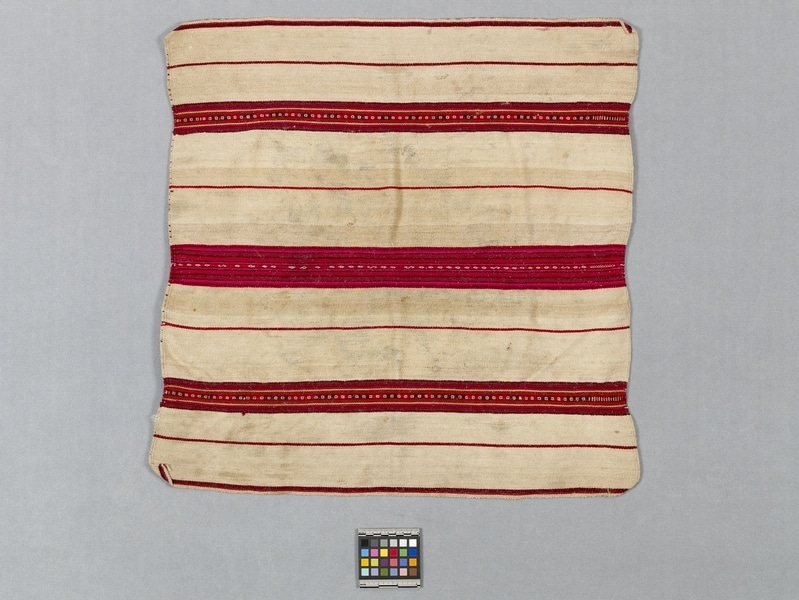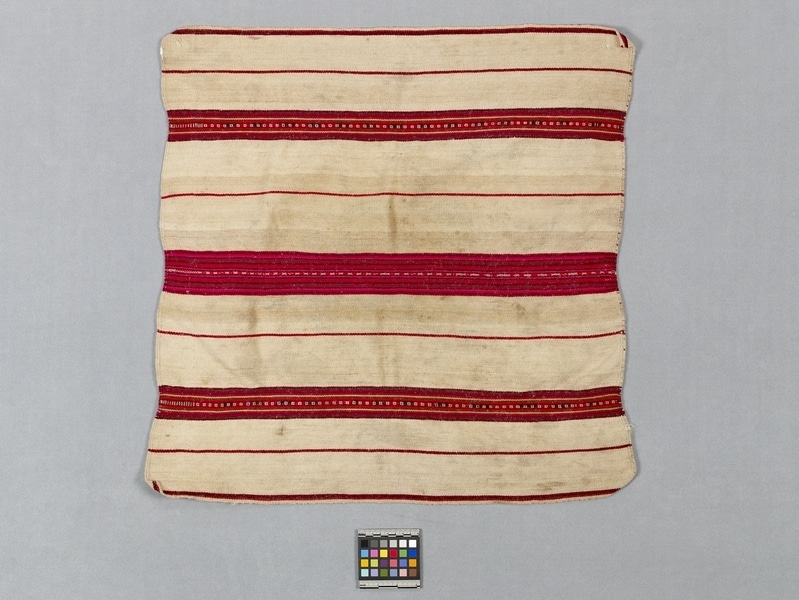Coca Cloth Item Number: Sf396 from the MOA: University of British Columbia


Description
Coca cloth made of off-white wool with three wide predominantly red bands with green, yellow and purple and pink stripes and thin bands of geometric pattern. Four narrow red and green stripes alternate with the wider groups. Red, green and pink stripes are placed near the edges, parallel to the other stripes.
History Of Use
Warp-faced fabric with three or four selvedges are woven by women but the fabrics are used by both sexes. The techniques, structures and some of the motifs have pre-Conquest antecedents. This type of textile conveys the most information about an individual's ethnicity, sex, age, status and particular history. Istalla with wide stripes are used in the offering of coca leaves, at life events like weddings, and in rituals enacted to influence nature, particularly offerings to Pachamama (the earth) in times of duress like droughts, floods or hail. The offering of coca leaves is an ancient Andean custom and special textiles are woven for personal coca use as well as ritual offerings.
Narrative
Bought from Lucia Huatta Huatta who made the cloth when she was a young girl, 20 to 25 years ago. Used in her own wedding with Francisco Marca Quispe. The coca leaves distributed to the wedding guests were placed on it. Also used in the weddings of her husband's brother, Andolin and sister, Trefana. Most recently used when Lucia and Francisco were padrinos or god parents at the wedding of Domingo Quispe Cruz and Elena Quispe Flores in July, 1987. Also used last year for making a coca offering to Pachamam (the earth) on Cerro Pucara when the rains did not come.
Iconographic Meaning
The motif of white squares is most frequently called the 'star of the Incas road'. The red and green stripe is called k'utu or teeth and the centre stripe is called nan or pathway.
Cultural Context
ritual
Specific Techniques
Alpaca and wool yarns are z spun and plied 2 s. Coloured synthetic yarns, z-2 s, are retwisted before warping. The background and stripes are warp-faced plain weave. The weave of the motifs in the centre stripe is a complementary warp weave with 3 span floats aligned in alternate pairs. The weave of the square motif is a float weave derived from a turned 2/1 horizontal herringbone. The complete fabric is one 4 selvedges.
Item History
- Made by Lucia Huatta Huatta (Maker) in Taquile, Puno, Peru between 1962 and 1970
- Collected by Mary Frame during 1987
- Owned by Mary Frame before November 3, 1987
- Received from Mary Frame (Seller) and Museum of Anthropology Shop Volunteers (Funding source) on November 3, 1987
What
- Name
- Coca Cloth
- Identification Number
- Sf396
- Type of Item
- cloth
- Material
- alpaca wool fibre, synthetic fibre, sheep wool fibre and dye
- Manufacturing Technique
- spun, dyed, woven and plied
- Overall
- height 63.2 cm, width 63.4 cm
Who
- Culture
- Quechua
- Creator
- Lucia Huatta Huatta (Maker)
- Field Collector
- Mary Frame
- Previous Owner
- Mary Frame
- Received from
- Mary Frame (Seller) and Museum of Anthropology Shop Volunteers (Funding source)
Where
- Holding Institution
- MOA: University of British Columbia
- Made in
- Taquile, Puno, Peru
When
- Creation Date
- between 1962 and 1970
- Collection Date
- during 1987
- Ownership Date
- before November 3, 1987
- Acquisition Date
- on November 3, 1987
Other
- Item Classes
- textiles
- Condition
- fair
- Accession Number
- 1274/0006